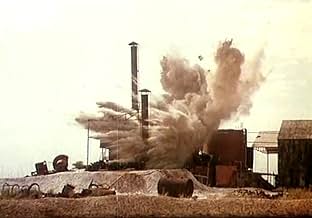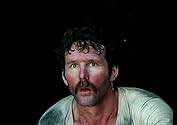Aggiungi una trama nella tua linguaBecause of a severe drought in Kenya in 1984, ninety thousand starving baboons go on a murderous rampage, killing humans and animals alike.Because of a severe drought in Kenya in 1984, ninety thousand starving baboons go on a murderous rampage, killing humans and animals alike.Because of a severe drought in Kenya in 1984, ninety thousand starving baboons go on a murderous rampage, killing humans and animals alike.
- Regia
- Sceneggiatura
- Star
Carl Vundla
- District Officer Tshombe
- (non citato nei titoli originali)
Recensioni in evidenza
A ridiculous story of a drought in Africa which results in 90,000 baboons deciding to attack humans as their only way of getting food. Yes, that's right, 90,000 red-assed baboons munch their way through the cast during this silly 97 minute horror flick. There's a fair bit of needless gore, which doesn't help, and lots of build ups which peter out without delivering an exciting or frightening pay-off. The only decent thing about this movie is John Rhys-Davies (who was so great in Raiders of the Lost Ark), who injects a bit of interest in a somewhat underwritten role.
We've certainly seen our share of killer primate movies. From 'Monkey Shines: An Experiment in fear' to 'Link', 'Shakma' and 'In the Shadow of Kilimanjaro'. (I'm not mentioning 'Congo' and 'King Kong' here because they weren't real animals). 'In the Shadow of Kilimanjaro' is undoubtedly one of the most realistic and terrifying of all.
Based on fact, the film depicts the moment when thousands of baboons turned to humans as food substitute during a drought. Entirely filmed on location in Kenya, this adds to the realism of the movie (so sad to think 'filmed on location' will soon be a thing of the past with the ever-growing use of CGI...).
Timothy Bottoms stars as ranger Jack Ringtree, whose wife Lee (Irene Miracle) comes to visit him begging to come home. Her timing couldn't have been worse, as all hell is about to break loose. Nearby, a mining company run by Chris Tucker (John Rhys-Davies) encounters several problems while running out of contract time, but things are about to get much worse as the baboons descent on the small town.
The attack scenes are brutal, realistic and simply terrifying. The use of real baboons makes it all the more scarier and the suspense is nail-biting. This is the stuff nightmares are made of!
'In the Shadow of Kilimanjaro' is one of my all-time favourite and most memorable 80's horror films.
Would I watch it again? Absolutely!
Based on fact, the film depicts the moment when thousands of baboons turned to humans as food substitute during a drought. Entirely filmed on location in Kenya, this adds to the realism of the movie (so sad to think 'filmed on location' will soon be a thing of the past with the ever-growing use of CGI...).
Timothy Bottoms stars as ranger Jack Ringtree, whose wife Lee (Irene Miracle) comes to visit him begging to come home. Her timing couldn't have been worse, as all hell is about to break loose. Nearby, a mining company run by Chris Tucker (John Rhys-Davies) encounters several problems while running out of contract time, but things are about to get much worse as the baboons descent on the small town.
The attack scenes are brutal, realistic and simply terrifying. The use of real baboons makes it all the more scarier and the suspense is nail-biting. This is the stuff nightmares are made of!
'In the Shadow of Kilimanjaro' is one of my all-time favourite and most memorable 80's horror films.
Would I watch it again? Absolutely!
My review was written in April 1986 after watching the film at a Times Square screening room.
Filmed over two years ago in Kenya, "In the Shadow of Kilimanjaro" is an old-fashioned adventure thriller in the borderline horror genre of a last-stand-at-the-house against predators, previously essayed in such films as "Kingdom of the Spiders", "Savage Harvest" and "Roar". Box office outlook is weak.
A famine has caused the 90,000 baboons on a Kenya wildlife reservation to begin banding together an preying on humans (film claims on-screen to be base on a true story, but the 1984 date given is impossible). Wildlife ranger John (Jack to his friends) Ringtree -played by Timothy Bottoms, wants to evacuate the area of about 200 people but the government and manager of the local mine Chris Tucker (John Rhys-Davies) view him as an alarmist and oppose his efforts. As usual in corny horror films like this one, the cast (especially female) is given to wandering alone in the bush long after word of animal attacks has been announced, making them easy prey.
Eventually the danger comes close to home and all survivors huddle together in a hotel run by Michele Carey. The last stand against the marauding animals is successful and a convenient rainstorm spells the end of the drought and the problem.
Hokey film benefits from atmospheric location photography, but suffers from sometimes inaudible dialog recorded in direct sound. Rhys-Davies uses a prop-cigar and a new accent in a fun job as a villain, but by the final reels he has become a true-blue good guy, with only the baboons as hissable targets. Bottoms is merely okay as the bland hero, Irene Miracle is extremely glamorous as his "please come home with met to America" nagging wife (in a role reserved decades ago in these films for Elsa Martinelli) and it's fun to see 1960s starlet Michele Carey again, as the friendly neighborhood hotelier. Leonard Trolley is so hammy as an old British colonial type recalling the good old days that one wishes he had been fed to the baboons early on.
Director Raju Patel substitutes gore effects for suspense in an episodic presentation that fails to knit individual scenes together. Unconvincing matte shots are used to show hundreds of baboons storming down from the hills, while more manageable stagings of a dozen or o animals are used to enact the attacks on humans. Situation inevitably conjures up memories of Cy Endfield's minor 1965 classic "Sands of the Kalahari", but instead of that film's genuinely chilling climax of the baboons descending in long shot on the surviving protagonist (which left the horror to one's imagination), we now get severed limbs, half-eaten faces and torsos and other ineffective gimmicks.
Filmed over two years ago in Kenya, "In the Shadow of Kilimanjaro" is an old-fashioned adventure thriller in the borderline horror genre of a last-stand-at-the-house against predators, previously essayed in such films as "Kingdom of the Spiders", "Savage Harvest" and "Roar". Box office outlook is weak.
A famine has caused the 90,000 baboons on a Kenya wildlife reservation to begin banding together an preying on humans (film claims on-screen to be base on a true story, but the 1984 date given is impossible). Wildlife ranger John (Jack to his friends) Ringtree -played by Timothy Bottoms, wants to evacuate the area of about 200 people but the government and manager of the local mine Chris Tucker (John Rhys-Davies) view him as an alarmist and oppose his efforts. As usual in corny horror films like this one, the cast (especially female) is given to wandering alone in the bush long after word of animal attacks has been announced, making them easy prey.
Eventually the danger comes close to home and all survivors huddle together in a hotel run by Michele Carey. The last stand against the marauding animals is successful and a convenient rainstorm spells the end of the drought and the problem.
Hokey film benefits from atmospheric location photography, but suffers from sometimes inaudible dialog recorded in direct sound. Rhys-Davies uses a prop-cigar and a new accent in a fun job as a villain, but by the final reels he has become a true-blue good guy, with only the baboons as hissable targets. Bottoms is merely okay as the bland hero, Irene Miracle is extremely glamorous as his "please come home with met to America" nagging wife (in a role reserved decades ago in these films for Elsa Martinelli) and it's fun to see 1960s starlet Michele Carey again, as the friendly neighborhood hotelier. Leonard Trolley is so hammy as an old British colonial type recalling the good old days that one wishes he had been fed to the baboons early on.
Director Raju Patel substitutes gore effects for suspense in an episodic presentation that fails to knit individual scenes together. Unconvincing matte shots are used to show hundreds of baboons storming down from the hills, while more manageable stagings of a dozen or o animals are used to enact the attacks on humans. Situation inevitably conjures up memories of Cy Endfield's minor 1965 classic "Sands of the Kalahari", but instead of that film's genuinely chilling climax of the baboons descending in long shot on the surviving protagonist (which left the horror to one's imagination), we now get severed limbs, half-eaten faces and torsos and other ineffective gimmicks.
This movie is suppose to tell the true tale about how 90,000 baboons went on a killing spree because of a severe drought in 1984. This movie bombed badly at the theaters. And it bombs badly as a movie itself. Did this really happen, I don't know. This movie is good for a laugh.
The basic plot of IN THE SHADOW OF KILIMANJARO (1986) is that an army of crazed, homicidal babboons are killing folks left and right in the middle of nowhere. The thing the filmmakers should of realised is that babboons always look kind of bored. An example comes in one scene where a movie character has a flat tire in the desert. We cut to shots of yawning, pre-occupied looking monkeys watch him from afar. They seem to be saying "Hoo-Hummm, I dunno, should I kill him? I don't know, rather sit here and pick flies off my fur. (Yawn....) Okay. Let me go down and kill 'em." We had a good laugh with this one.
Lo sapevi?
- Quiz[Postscript] The film you have just seen is a fictionalized account of a true incident which took place in Africa during the serious drought in 1984. The producers wish to make it known that not a single animal was mistreated during the making of this motion picture. On completion of filming the Baboons were rehabilitated to their natural surroundings. The Baboons were captured under the supervision of the Kenyan Ministry of Tourism and Wildlife from the areas where they had been a nuisance to the local population.
- Curiosità sui crediti[Postscript] The film you have just seen is a fictionalized account of a true incident which took place in Africa during the serious drought in 1984. The producers wish to make it known that not a single animal was mistreated during the making of this motion picture. On completion of filming, the Baboons were rehabilitated to their natural surroundings. The Baboons were captured under the supervision of the Kenyan Ministry of Tourism and Wildlife from the areas where they had been a nuisance to the local population.
- ConnessioniFeatured in Trailer Trauma 3: 80s Horrorthon (2017)
- Colonne sonoreIn the Shadow of the Kilimanjaro
Words and Music by Chieli Minucci & Allan Smallwood
I più visti
Accedi per valutare e creare un elenco di titoli salvati per ottenere consigli personalizzati
- How long is In the Shadow of Kilimanjaro?Powered by Alexa
Dettagli
Botteghino
- Lordo Stati Uniti e Canada
- 181.410 USD
- Fine settimana di apertura Stati Uniti e Canada
- 181.410 USD
- 11 mag 1986
Contribuisci a questa pagina
Suggerisci una modifica o aggiungi i contenuti mancanti















